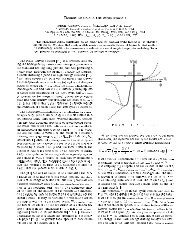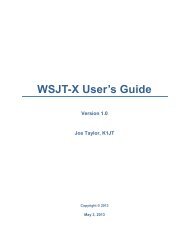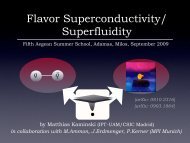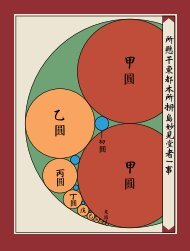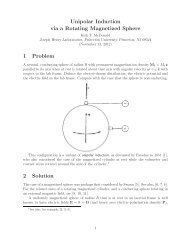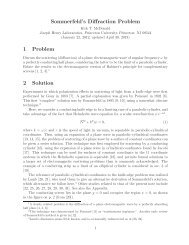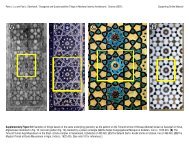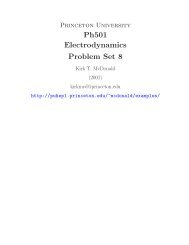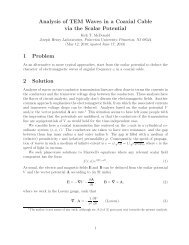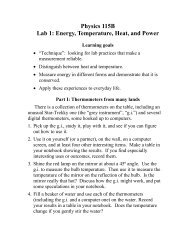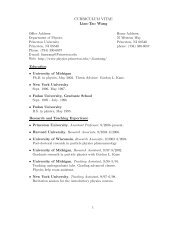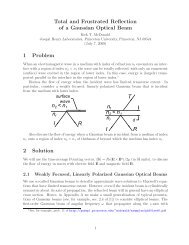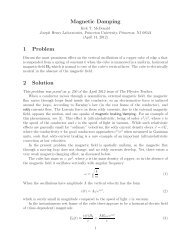Electromagnetic Fields of a Small Helical Toroidal Antenna 1 ...
Electromagnetic Fields of a Small Helical Toroidal Antenna 1 ...
Electromagnetic Fields of a Small Helical Toroidal Antenna 1 ...
You also want an ePaper? Increase the reach of your titles
YUMPU automatically turns print PDFs into web optimized ePapers that Google loves.
1 Problem<br />
<strong>Electromagnetic</strong> <strong>Fields</strong> <strong>of</strong> a<br />
<strong>Small</strong> <strong>Helical</strong> <strong>Toroidal</strong> <strong>Antenna</strong><br />
Kirk T. McDonald<br />
Joseph Henry Laboratories, Princeton University, Princeton, NJ 08544<br />
(December 8, 2008)<br />
Discuss the electromagnetic fields <strong>of</strong> a helical toroidal winding with major radius a and<br />
minor radius b, as shown below, that carries an oscillatory surface current Ke −iωt that has<br />
no azimuthal component. There is no accumulation <strong>of</strong> charge anywhere, i.e., ∇ · K =0. It<br />
suffices to consider the limit that ka ≪ 1wherek = ω/c is the wave number and c is the<br />
speed <strong>of</strong> light.<br />
A physical realization <strong>of</strong> this winding is shown on the right above, as perhaps first proposed<br />
by Corum [1], where two counter windings <strong>of</strong> N/2 turns are each driven with current<br />
I =2πaK(ρ = a)e −iωt /N such that the magnetic dipole moment is zero. A complication<br />
in this case is that at the N close crossings <strong>of</strong> the two windings, there is localized, oscillating<br />
charge accumulation due to the capacitance between the nearby wires which leads to<br />
azimuthal variation <strong>of</strong> the currents in the windings.<br />
2 Solution<br />
2.1 Sheet Currents with No Azimuthal Variation<br />
This solution follows [2], which assumed sheet currents as stated above. See also [3, 4, 5, 6, 7].<br />
A discussion that emphasizes the fields close to the toroid is givn in [8]. The possibility <strong>of</strong><br />
an elementary particle, called an “anapole,” with a helical toroidal field was considered by<br />
Zel’dovitch in 1958 [9].<br />
We first consider the static limit <strong>of</strong> sheet currents represented by N turns <strong>of</strong> steady<br />
current I 0 with no azimuthal component. Then, the electric field is zero everywhere, the<br />
magnetic field is zero outside the torus, while inside the torus we use Ampère’s law (in<br />
1
Gaussian units) to find<br />
⎧<br />
⎪⎨ 2NI 0 ˆφ/cρ (inside torus),<br />
B static =<br />
⎪⎩ 0 (outside torus),<br />
(1)<br />
where ρ = √ x 2 + y 2 .<br />
The fact that both the static electric and magnetic vanish outside the torus implies that<br />
all multiple moments vanish for a conventional multipole expansion in this region. However,<br />
the vector potential is certainly nonzero inside the torus, so that continuity <strong>of</strong> the vector<br />
potential at its surface implies that the vector potential is nonzero outside the torus as well. 1<br />
To find the vector potential, and the electric and magnetic field, in the case <strong>of</strong> oscillating<br />
currents in the windings, we follow a method due to Hertz. The electric and magnetic fields<br />
E and B can be derived from the scalar and vector potentials V and A according to<br />
E = −∇V − 1 ∂A<br />
, B = ∇ × A, (2)<br />
c ∂t<br />
in Gaussian units. We work in the Lorentz gauge where the potentials satisfy the auxiliary<br />
condition<br />
∇ · A = − 1 ∂V<br />
c ∂t . (3)<br />
The potentials then obey the wave equations<br />
∇ 2 A − 1 ∂ 2 A<br />
c 2 ∂t = −4π 2 c J, ∇2 V − 1 ∂ 2 V<br />
= −4πϱ, (4)<br />
c 2 ∂t2 where ϱ and J are the charge and current densities <strong>of</strong> the sources <strong>of</strong> the waves. Formal<br />
solutions for the (retarded) vector potential have been given by Lorenz,<br />
A(r,t)= 1 c<br />
∫<br />
J(r ′ ,t ′ = t − R/c)<br />
dVol ′ ,<br />
R<br />
∫<br />
V(r,t)=<br />
ϱ(r ′ ,t ′ = t − R/c)<br />
dVol ′ , (5)<br />
R<br />
where R = |r − r ′ |.<br />
There is nowhere any accumulation <strong>of</strong> charge in the present problem, so that ϱ =0and<br />
hence the scalar potential V is zero as well. In this case, the Lorentz gauge condition (3)<br />
tells us that<br />
∇ · A =0, (6)<br />
so that the vector potential can be written as the curl <strong>of</strong> another vector, which we will call<br />
Z M ,themagnetic Hertz vector: 2 A = ∇ × Z M . (7)<br />
From the wave equation (4) for the vector potential, we have<br />
∇ 2 A = ∇ 2 (∇ × Z M )=∇ ×∇ 2 Z M = 1 c 2 ∂ 2 A<br />
∂t 2<br />
− 4π c J = ∇ × 1 c 2 ∂ 2 Z M<br />
∂t 2 − 4π c J (8)<br />
1 Aharonov and Bohm [10] have discussed quantum phenomena in the regions <strong>of</strong> zero magnetic field but<br />
nonzero vector potential.<br />
2 For additional discussion <strong>of</strong> electric and magnetic Hertz vectors and scalars, see the Appendix <strong>of</strong> [11].<br />
2
If we write the current density as<br />
J = c∇ × M, (9)<br />
in terms <strong>of</strong> a magnetization density M, the magnetic Hertz vector satisfies the wave equation<br />
∇ 2 Z M − 1 ∂ 2 Z M<br />
= −4πM. (10)<br />
c 2 ∂t 2<br />
This justifies the alternative terminology that the magnetic Hertz vector is a polarization<br />
potential, with the formal solution<br />
∫<br />
Z M (r,t)=<br />
M(r ′ ,t ′ = t − R/c)<br />
dVol ′ . (11)<br />
R<br />
If we regard the static magnetic field (1) inside the torus as due to a magnetization<br />
density M rather than a conduction current density J or K, thenH = B − 4πM =0,sothe<br />
required magnetization is<br />
M static = B static<br />
4π<br />
⎧<br />
⎪⎨ NI 0 ˆφ/2πcρ (inside torus),<br />
=<br />
⎪⎩ 0 (outside torus).<br />
In the case <strong>of</strong> an oscillating current I 0 e −iωt , the equivalent oscillating magnetization is<br />
(12)<br />
M(ρ, t) =M static (ρ)e −iωt . (13)<br />
Using this in eq. (11), the magnetic Hertz vector is given by<br />
∫ Mstatic (ρ ′ )e i(kR−ωt)<br />
Z M (r,t)=<br />
dVol ′ . (14)<br />
R<br />
For an approximate solution, we use the relations<br />
R ≈ r − ˆr · r ′ ,<br />
where the term in 1/r 2 improves the accuracy at small r. Then, 3<br />
Z M (r,t) ≈ ei(kr−ωt)<br />
r<br />
∫<br />
≈ NI 0 e i(kr−ωt)<br />
2πc r<br />
1<br />
R ≈ 1 (<br />
1+ˆr · )<br />
r′<br />
, (15)<br />
r r<br />
( )<br />
M static (ρ ′ )e −ikˆr·r′ 1+ r′ · ˆr<br />
dVol ′<br />
r<br />
∫ φ<br />
′ [ ( ) ]<br />
1<br />
1+<br />
ρ ′ r − ik ˆr · r ′ dVol ′ (16)<br />
We evaluate integral (16) for r in spherical coordinates (r, θ, φ) but r ′ in cylindrical coordinates<br />
(ρ, φ, z), and for an observer at distance r ≫ a from the origin. In rectangular<br />
coordinates, ˆr = (sinθ cos φ, sin θ sin φ, cos θ), r ′ = (ρ ′ cos φ ′ ,ρ ′ sin φ ′ ,z ′ )and ˆφ ′ =<br />
3 Expanding the factor e ik·r′ to first order in r ′ in the Hertz vector Z M corresponds to expanding this<br />
factor to second order in the vector potential A, which corresponds to keeping (magnetic) quadrupole terms<br />
in the current density distribution.<br />
3
− cos φ ′ ˆx +sinφ ′ ŷ,sothat<br />
Z M (r ≫ a, t) ≈ NI 0 e i(kr−ωt) ∫ − cos φ′ ˆx +sinφ ′ ŷ<br />
×<br />
2πc r<br />
ρ ′ [ ( )<br />
]<br />
1<br />
× 1+<br />
r − ik [ρ ′ (cos φ ′ sin θ cos φ +sinφ ′ sin θ sin φ)+z ′ cos θ] dVol ′<br />
= NI 0V<br />
4πc<br />
= NI 0V<br />
4πc<br />
e i(kr−ωt)<br />
r<br />
e i(kr−ωt)<br />
where V =2π 2 ab 2 is the volume <strong>of</strong> the torus.<br />
The vector potential is<br />
A(r ≫ a, t)=∇ × Z M ≈ NI 0V<br />
4πc<br />
r<br />
( 1<br />
r − ik )<br />
sin θ (− cos φ ˆx +sinφ ŷ)<br />
( 1<br />
r − ik )<br />
sin θ ˆφ, (17)<br />
e i(kr−ωt) [<br />
r<br />
( 1<br />
2<br />
r − ik 2 r<br />
)<br />
cos θ ˆr +<br />
The static vector potential is obtained by setting ω and k to zero,<br />
( 1<br />
r 2 − ik r − k2 )<br />
sin θ ˆθ<br />
]<br />
.<br />
(18)<br />
A static (r ≫ a) ≈ NI 0V<br />
4πcr 3 (2 cos θ ˆr +sinθ ˆθ) = 3(m T · ˆr)ˆr − m T<br />
r 3 , (19)<br />
where<br />
m T = NI 0V ẑ. (20)<br />
4πc<br />
That is, the static vector potential outside the torus has the form <strong>of</strong> the magnetic field <strong>of</strong><br />
a magnetic dipole m T given by eq. (20), although the actual magnetic dipole moment <strong>of</strong><br />
the toroidal winding is zero. The quantity m T <strong>of</strong> eq. (20) has been called the toroid dipole<br />
moment [5] because if this moment oscillates it generates an electric field formally similar to<br />
that <strong>of</strong> an oscillating electric dipole (see eq. (21)). However, the moment (20) is the result<br />
<strong>of</strong> weighting the current density J by two powers <strong>of</strong> distance, rather than by one, and so is<br />
an aspect <strong>of</strong> the magnetic quadrupole moment <strong>of</strong> the current density.<br />
The electric and magnetic fields outside the torus are<br />
E(r ≫ a, t) = − 1 c<br />
≈<br />
∂A<br />
∂t = ikA<br />
ik NI 0V<br />
4πc<br />
e i(kr−ωt) [<br />
r<br />
(<br />
1<br />
2<br />
r − ik 2 r<br />
) (<br />
1<br />
r − ik ) ]<br />
2 r − k2<br />
cos θ ˆr +<br />
sin θ ˆθ<br />
= ik 3 ei(kr−ωt)<br />
(ˆr × m T ) × ˆr +(ik + k 2 r)e i(kr−ωt) 3(m T · ˆr)ˆr − m T<br />
, (21)<br />
r<br />
r 3<br />
B(r ≫ a, t) = ∇ × A ≈−ik NI 0V e i(kr−ωt) (<br />
1<br />
4πc r r + ik )<br />
2 r + k2 sin θ ˆφ<br />
(<br />
= ik 3 1 − 1<br />
ikr + 1 ) e<br />
i(kr−ωt)<br />
ˆr × m<br />
k 2 r 2 T . (22)<br />
r<br />
4
Both E and B vanish outside the torus in the static limit k = 0. The radiation fields are<br />
e i(kr−ωt)<br />
E rad,θ = B rad,φ = −ik 3 NI 0V<br />
sin θ. (23)<br />
4πc r<br />
The fields (21)-(22) have the same form as those for a small oscillating electric dipole, except<br />
that they are multiplied by an additional factor <strong>of</strong> k. And indeed, in a systematic multipole<br />
expansion <strong>of</strong> the sources <strong>of</strong> vector electromagnetic fields (see, for example, sec. 9.10 <strong>of</strong> [12]) an<br />
oscillating magnetization can contribute to the electric dipole moment, but with an additional<br />
factor <strong>of</strong> k compared to the part <strong>of</strong> the electric dipole moment due to the electric charge<br />
distribution.<br />
The time-average radiated power has the angular distribution<br />
dP rad<br />
dΩ = 1<br />
8πc<br />
and the time-average radiated power is<br />
where the radiation resistance R rad is given by<br />
R rad = 1 3c<br />
( NVk<br />
3<br />
4π<br />
( NI0 Vk 3 ) 2<br />
sin 2 θ, (24)<br />
4π<br />
P rad = 1 2 R radI 2 0, (25)<br />
) 2<br />
= π2 (<br />
Nk 3 ab 2) 2 16π 8 ( ) Nab<br />
2 2 ( ) Nab =<br />
12c<br />
3c λ 3 ≈ 1.5 × 10 6 2 2<br />
λ 3 Ω. (26)<br />
For example, if a = λ/10, b = λ/100 and N ≈ 580 turns, then R rad =50Ω.<br />
Of course, the inductance L <strong>of</strong> such a winding is high. In SI units, the inductance is<br />
L = μ 0N 2 b 2<br />
2πa . (27)<br />
For the above example, L ≈ 0.007 b henries for b in meters.<br />
2.2 Counter-Wound <strong>Helical</strong> <strong>Toroidal</strong> <strong>Antenna</strong><br />
We give only a qualitative discussion <strong>of</strong> the counter-wound helical toroidal antenna, using<br />
thecasethatN = 8 as an example.<br />
As shown in the sketch below, the 8 = 2×4 turns can be thought <strong>of</strong> as forming 8 elongated<br />
loops, each <strong>of</strong> which is formed from a half turn <strong>of</strong> each <strong>of</strong> the two counter windings, indicated<br />
as diamonds on the left part <strong>of</strong> the figure. We suppose that the wires <strong>of</strong> the two windings<br />
pass so close to one another that the capacitance <strong>of</strong> the 8 crossing points <strong>of</strong> the two windings<br />
is very large. Then, there exist resonant frequencies at which the direction <strong>of</strong> the current in<br />
each winding reverses at each crossing point, and the toroid dipole moment (20) vanishes.<br />
5
Each <strong>of</strong> these loops has a magnetic moment m j that is perpendicular to the plane <strong>of</strong> each<br />
loop, and which lies in the x-y plane, as shown on the right part <strong>of</strong> the figure.<br />
At each <strong>of</strong> the 8 crossing points <strong>of</strong> the wires there is a large capacitance, and a corresponding<br />
electric dipole moment p j that points towards (or away from) the center <strong>of</strong> the<br />
toroid.<br />
All electric and magnetic multipole moments <strong>of</strong> order less than N vanish, so the radiation<br />
from the system is highly suppressed.<br />
Foranobserveronthez axis, above the center <strong>of</strong> the antenna, the radiation electric field<br />
vectors from the 8 magnetic moments m j and from the 8 electric dipole moments p j are<br />
parallel to the x-y plane. The sum <strong>of</strong> the radiation electric fields is zero, and hence, there is<br />
no radiation along the z axis.<br />
An observer in the x-y plane sees very small electric field from the 8 electric dipole<br />
moments, while the electric field from the 8 magnetic moments sums to a nonzero vertical<br />
component.<br />
The overall pattern <strong>of</strong> the radiation electric field is that it is largest, and approximately<br />
independent <strong>of</strong> azimuth, in the x-y plane, while vanishing along the z direction. This is the<br />
qualitative character <strong>of</strong> electric dipole radiation from an oscillating dipole moment directed<br />
along the z-axis. However, it is ironic that when a counter-wound helical toroidal antenna<br />
is operated at resonance, the toroid dipole moment vanishes, and this exotic antenna configuration<br />
reduces to a circular array <strong>of</strong> “ordinary” electric and magnetic dipoles.<br />
There exist some analytic studies in the literature for the case <strong>of</strong> small N [14, 15], but<br />
some <strong>of</strong> their conclusion are at odds with the present analysis.<br />
A<br />
Appendix: The Chu Limit<br />
One design goal <strong>of</strong> small antennas is a large bandwidth. In classic papers, Wheeler [17] and<br />
Chu [18] noted that there is a limit to the bandwidth <strong>of</strong> an antenna that fits inside a sphere<br />
6
<strong>of</strong> radius R ≪ λ that can be expressed as a lower limit on the Q <strong>of</strong> the antenna,<br />
Q = ω 〈U near〉<br />
〈P rad 〉<br />
><br />
∼<br />
1<br />
4(kR) 3 , (28)<br />
where 〈U near 〉 is the time-averaged energy stored in the non-propagating near electromagnetic<br />
fields <strong>of</strong> the antenna and 〈P rad 〉 is the time-average radiated power. See also [19]. The bound<br />
(28) is closely approached by a small linear dipole antenna <strong>of</strong> half-height R.<br />
This argument is based on a decomposition <strong>of</strong> the fields <strong>of</strong> the antenna into multipole<br />
moments. Since the counter-wound helical toroidal antenna has no nonzero electric or magnetic<br />
multipole moments <strong>of</strong> the usual sort, it could be that this type <strong>of</strong> antenna can have<br />
a Q smaller than the limit <strong>of</strong> eq. (28). We saw in sec. 2.1 that the fields outside the windings<br />
<strong>of</strong> a small counter-wound helical toroidal antenna are essentially the same as those <strong>of</strong> a<br />
small electric dipole antenna. Hence, the part <strong>of</strong> Q <strong>of</strong> a small counter-wound helical toroidal<br />
antenna associated with the fields outside the windings is essentially the same as that <strong>of</strong> a<br />
small electric dipole antenna, and therefore satisfies the bound (28). However, 〈U near 〉 also<br />
includes the energy stored inside the windings,<br />
〈U inside 〉 = 1 2 LI 2 0 , (29)<br />
where L =2πN 2 b 2 /c 2 a in Gaussian units. This energy is much larger than that stored in<br />
the near fields outside the windings. Then, recalling eqs. (25)-(26),<br />
Q ≈ ωL = ω 2πN2 b 2 12c<br />
R rad c 2 a π 2 N 2 a 2 b 4 k = 24<br />
6 πk 5 a 2 b ≫ 1<br />
3 4(ka) . (30)<br />
3<br />
Thus, a small counterwound helical toroidal antenna is a high-Q device and does not come<br />
close to satisfying the Chu limit.<br />
References<br />
[1] J.F. Corum, <strong>Toroidal</strong> Helix <strong>Antenna</strong>, IEEE Ant. Prop. Int. Symp. 25, 832 (1987),<br />
http://puhep1.princeton.edu/~mcdonald/examples/EM/corum_ieeeapsis_25_832_87.pdf<br />
[2] N.J. Carron, On the fields <strong>of</strong> a torus and the role <strong>of</strong> the vector potential, Am. J.Phys.<br />
63, 717 (1995),<br />
http://puhep1.princeton.edu/~mcdonald/examples/EM/carron_ajp_63_717_95.pdf<br />
[3] V.M. Dubovik and A.A. Cheshkov, Multipole expansion in classical and quantum field<br />
theory and radiation, Sov.J.Part.Nucl.5, 318 (1975),<br />
http://puhep1.princeton.edu/~mcdonald/examples/EM/dubovik_sjpn_5_318_75.pdf<br />
[4] V.M. Dubovik and L.A. Tosunyan, <strong>Toroidal</strong> moments in the physics <strong>of</strong> electromagnetic<br />
and weak interactions, Sov.J.Part.Nucl.14, 504 (1983),<br />
http://puhep1.princeton.edu/~mcdonald/examples/EM/dubovik_sjpn_14_504_83.pdf<br />
7
[5] V.M. Dubovik and V.V. Tugushev, Toroid Moments in Electrodynamics and Solid-State<br />
Physics, Phys.Rep.187, 145 (1990),<br />
http://puhep1.princeton.edu/~mcdonald/examples/EM/dubovik_pr_187_145_90.pdf<br />
[6] G.N. Afanasiev, The electromagnetic fields <strong>of</strong> solenoids with time dependent currents,<br />
J. Phys. A: Math. Gen. 23, 5755 (1990),<br />
http://puhep1.princeton.edu/~mcdonald/examples/EM/afanasiev_jpa_23_5755_90.pdf<br />
[7] I. Dumitriu and C. Vrejoiu, Some Aspects <strong>of</strong> <strong>Electromagnetic</strong> Multipole Expansions,<br />
Rom. Rep. Phys. 60, 423 (2008),<br />
http://puhep1.princeton.edu/~mcdonald/examples/EM/dumuitriu_rrp_60_423_08.pdf<br />
[8] C.H. Page, External Field <strong>of</strong> an Ideal Toroid, Am.J.Phys.39, 1039 (1971),<br />
http://puhep1.princeton.edu/~mcdonald/examples/EM/page_ajp_39_1039_71.pdf<br />
On the External Magnetic Field <strong>of</strong> a Closed-Loop Core, Am.J.Phys.39, 1206 (1971),<br />
http://puhep1.princeton.edu/~mcdonald/examples/EM/page_ajp_39_1206_71.pdf<br />
[9] Y.B. Zel’dovitch, <strong>Electromagnetic</strong> Interaction with Parity Violation, Sov.Phys.JETP<br />
6, 1184 (1958),<br />
http://puhep1.princeton.edu/~mcdonald/examples/EM/zeldovich_jetp_6_1184_58.pdf<br />
[10] Y. Aharonov and D. Bohm, Significance <strong>of</strong> <strong>Electromagnetic</strong> Potentials in the Quantum<br />
Theory, Phys.Rev.115, 485 (1959),<br />
http://puhep1.princeton.edu/~mcdonald/examples/QM/aharonov_pr_115_485_59.pdf<br />
[11] K.T. McDonald, Radiation in the Near Zone <strong>of</strong> a <strong>Small</strong> Loop <strong>Antenna</strong> (June 7, 2004),<br />
http://puhep1.princeton.edu/~mcdonald/examples/smallloop.pdf<br />
[12] J.D. Jackson, Classical Electrodynamics, 3rd ed. (Wiley, New York, 1999).<br />
[13] K.T. McDonald, Electrodynamics Problem Set 8 (2001),<br />
http://puhep1.princeton.edu/~mcdonald/examples/ph501set8.pdf<br />
[14] D.B. Miron, A Study <strong>of</strong> the CTHA Based on Analytical Models, IEEE Trans. Ant.<br />
Prop. 49, 1130 (2001),<br />
http://puhep1.princeton.edu/~mcdonald/examples/EM/miron_ieeetap_49_1130_01.pdf<br />
[15] R.C. Hansen, <strong>Fields</strong> <strong>of</strong> the Contrawound <strong>Toroidal</strong> Helix <strong>Antenna</strong>, IEEE Trans. Ant.<br />
Prop. 49, 1138 (2001),<br />
http://puhep1.princeton.edu/~mcdonald/examples/EM/hansen_ieeetap_49_1138_01.pdf<br />
[16] K.T. McDonald, Distortionless Transmission Line (Nov. 11, 1996),<br />
http://puhep1.princeton.edu/~mcdonald/examples/distortionless.pdf<br />
[17] H.A. Wheeler, Fundamental Limitations <strong>of</strong> <strong>Small</strong> <strong>Antenna</strong>s, Proc. IRE 35, 1479 )1047),<br />
http://puhep1.princeton.edu/~mcdonald/examples/EM/wheeler_pire_35_1479_47.pdf<br />
[18] L.J. Chu, Physical Limitations <strong>of</strong> Omni-directional <strong>Antenna</strong>s, J.Appl.Phys.19, 1163<br />
(1948), http://puhep1.princeton.edu/~mcdonald/examples/EM/chu_jap_19_1163_48.pdf<br />
8
[19] J.S. McLean, A Re-Examination <strong>of</strong> the Fundamental Limits on the Radiation Q <strong>of</strong><br />
Electrically <strong>Small</strong> <strong>Antenna</strong>s, IEEE Trans. Ant. Prop. 44, 672 (1996),<br />
http://puhep1.princeton.edu/~mcdonald/examples/EM/mclean_ieeetap_44_672_96.pdf<br />
9



